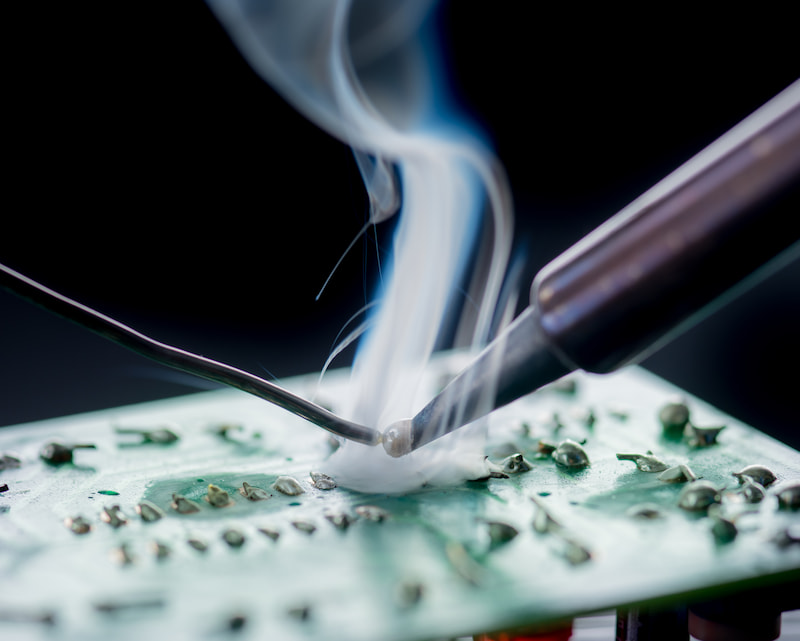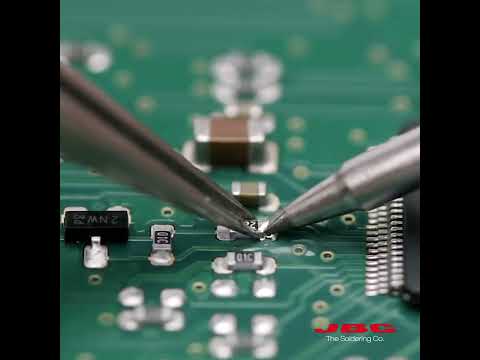Soldering is a process that joins two or more types of metals through melting solder. The first soldering iron was developed in 1896 by Richard Schneider and August Tinnerhol and was called the “First Electric Heating Apparatus”.
Soldering is commonly used in electronics, as it is simple and safe in joining sensitive materials. Likewise, the process is also known for metalworking, plumbing, roofing and joining wires. Let’s take an in-depth look into soldering to find out more.
- Soldering is a process that joins metals using a filler metal, typically an alloy of tin and lead, which melts at lower temperatures compared to the base metals.
- The three main types of soldering are soft soldering, hard soldering and brazing, each varying by the temperature required and the strength of the final joint.
- Soldering is widely used in electronics, plumbing, and metalworking, offering precise and reliable joints, especially for small and sensitive components.
- While soldering is simpler and safer than welding, it produces weaker joints and isn't suitable for high-stress and high-temperature environments.
What Is Soldering?
Soldering uses a filler metal with a low melting point, also known as solder, to join metal surfaces. The solder is usually made up of an alloy consisting of tin and lead whose melting point is around 235°C and 350°C, respectively.
But when tin and lead are mixed then the melting point of the mixture is reduced to 183°C. The alloy is melted by using a hot iron at above 316 °C (600 °F).
As the solder cools, it creates a strong electrical and mechanical bond between the metal surfaces. The bond allows the metal parts to achieve electrical contact while it is held in place.
Note that lead-free solders are increasingly used as an alternative to environmentally harmful lead-based solders due to regulations.
Soldering Process
ARVE error: url: https://www.googleapis.com/youtube/v3/videos?part=snippet%2Cstatistics&id=E3bNNQZCQAI&key=AIzaSyAQ7WFzTAUrOX-FjsIrFS3JwZBFzgIvloc Status code 200 expected but was 403.
The first step in soldering is to wear protective gear in a well-ventilated area. Next, the soldering iron should be preheated. For cleaning the soldering tip, you can use a wet sponge. Likewise, any residue on the workpiece surface should be wiped off.
After finishing the preparations, it’s time to heat the base metal to a working temperature using the hot iron. Doing so will help prevent thermal shock, activate the solder, and overall improve the quality of the joint. A good indicator that the metals are well-heated is when the molten solder freely flows into the joint. The filler material solidifies as it cools down, making it the best time for inspection.
The key to successful soldering is ensuring that the metals being joined are clean and free of any oxides or other contaminants.
Desoldering
From time to time, components fail and need replacement. When these components are mechanically held in place with solder, a process called desoldering removes the material cleanly and safely.
A soldering iron or a heat gun can be utilised to melt the solder, allowing you to safely remove any soldered components. To remove the liquid solder, you can use a desoldering pump as a vacuum, or a soldering wick to absorb the molten solder.
Alternatively, you can resort to an aggressive method using compressed air that can blow off the liquid solder.
Soldering vs Welding
While soldering and welding are processes that join two pieces of metal alloy together, there are some key differences in how the metals are joined.
Soldering uses melted filler metals to bond heated base materials. It works at a lower temperature than welding but requires preheating the base materials to create an effective joint.
Welding runs at higher temperatures to melt both filler material and workpiece together. It results in a stronger bond, with some changes to the mechanical properties of the metal from heating and cooling.
Metals
Soldering works well with the following base metals:
-
Gold
-
Silver
-
Iron
-
Brass
-
Copper
-
Aluminium
-
Steel
-
Titanium
While some of these metals can easily be soft-soldered, harder metals may require filler materials with a higher melting point to be joined.
Soldering Tools
Soldering irons are hand tools that heat the solder above its melting temperatures. They offer a wide variety of sizes, which is great for different applications. The tip of the iron has different types and sizes that suit a variety of projects.
Soldering guns are employed when higher temperatures require more power. A soldering gun heats quicker and offers better flexibility as it can be operated in confined spaces, heavy electrical connections, and metalworks.
Soldering stations are multipurpose devices that have everything covered for minor projects. They are more durable than regular soldering irons due to them being equipped with sensors, fuses, alerts and temperature regulation.
Solders
Lead-based solder
Most soldering projects are typically performed using lead solder consisting of a 60-40 tin-to-lead ratio. This solder melts in a range of 180 to 190°C and is usually the best choice for soldering electrical connections.
Lead-free solder
As a way to mitigate the use of harmful elements, lead-free solders were developed. These usually come as solder wire and are composed of metals with higher melting points: tin, copper, bismuth, silver, brass, indium, and antimony (often categorised as a metalloid).
Flux core solder
These filler metals come as paste or soldering wires that contain a flux solder core. The flux releases a protective layer around the workpiece as it is consumed, which achieves cleaner electronic connections and better wetting properties.
- Personal account manager
- Quality assurance
- Payment terms for companies
- On-time delivery by Fractory
Flux
Rosin flux (alternatively called passive flux) is used for electronics as it leaves a residue that doesn’t lead to corrosion.
Acid flux solders contain aggressive properties, which are effective in removing the oxides of the metal surface. This leads to stronger and cleaner metal joints compared to rosin.
The type of flux can be broken down into two groups depending on its application. No-clean flux is made with natural rosin or other synthetic materials, requiring no post-cleanup, while water-soluble flux contains water-soluble resin that is easily removed by rinsing.
Heating Methods

While the concept of soldering is fairly simple, there are different heating methods that depend on the application or project. Primitive methods involve a fire heating element through butane, but this has now evolved into more advanced techniques.
Laser
Commonly used in delicate electronics, lasers at 30-50 watts can accurately create a soldered joint while preventing heat in the surrounding area. It is commonly used on circuit boards where the components are compact.
Induction
Copper coils induce heat to the solder by using an oscillating high-frequency alternating current. Induction allows for an even application of thermal energy to heat solder, being a great application to cylinders and pipes, minimizing holes and maintaining uniformity.
Resistance
This soldering form generates heat by applying an electrical current to the solder and soldering iron. Heat is generated in a small space and it dissipates quickly, reducing the risk of damaging components.
Infrared
This method uses infrared (IR) light as a mode of heat transfer to the targeted area. It only takes a few seconds, reducing the heat exposure time of the surrounding area.
Types of Soldering
Here are three soldering types that are used at varying temperature levels that result in different joint strengths:
-
Soft soldering (90 °C – 450 °C)
The solder melts alloys containing lead that has a low melting point. With a lower melting point, this soldering type minimises the thermal stress wherein the base metals are subjected.
-
Hard soldering (above 450 °C)
Brass and silver are usually hard soldered, with the use of a flame via blowtorch to melt the filler metal. Hard soldering has better mechanical strength than soft soldering, which applies to crafting jewellery and some machining operations.
-
Brazing (above 450 °C)
Brazing uses metals with a much higher melting point compared to hard and soft soldering. It produces the strongest result, which is perfect for metal repairs and for pipe joining.
Advantages of Soldering
-
Soldering is operated at lower temperatures compared to common welding methods.
-
Most metals and non-metals can be soldered.
-
A simple process makes it easy to learn.
-
The base metal isn’t melted in the process, unlike welding techniques such as stick welding, flux-cored welding, etc.
-
Soft soldering can be undone using a desoldering tool without damaging the base materials.
Disadvantages of Soldering
-
Weaker joints compared to other welding methods such as MIG and TIG.
-
Soldering isn’t suitable at high temperatures, as the solder has a low melting point.
-
Heavy metals aren’t suitable for soldering.
-
Melted solder might leave a toxic flux residue.
-
Improper heating may cause deformities or voids in the solder.
Applications

Electronics Industry
The most popular application of this fusion process is electronics soldering, where wires are joined and electronic components are fused to a circuit board. This technique allows soldering components together with the luxury of desoldering when needed.
Roofings
Soldering can be used in creating leak-proof roofings wherein the galvanised steel is infused with solder. The soldering iron tip is far broader when used in this application compared to other uses.
Sections
Soldering is applied in the piping and plumbing industry as a way to create joint sections. It is a straightforward process and a reliable solution in sealing the connections in copper pipes, for example.
Art
Soldering can be used to create stained glass art, wire modelling, sculptures, jewellery and other creative works.
Metalwork
The soldering material can be used to fill cavities and even out rough surfaces. This process is practiced to fuse metal sheets, pipes and other applications where metals don’t undergo high temperatures.
Automation
Technology allows us to automate the soldering process through the use of programmed robots. Not only does it create precise joints but it is also fast in production speed.
Important Points to Remember
Soldering plays a vital role in the electronic industry along with several applications. When done correctly, it can provide strong and reliable mechanical joints.
While the fundamental concept of soldering is simple, innovations are reshaping how this process is done, offering more versatility and usability. Today’s technology allows automation, similar to welding processes like MIG and spot welding, with different solders depending on the application.
As we continue to traverse into micro and nanotechnology, it’s very likely that soldering or another similar form will develop to join these small electronic parts.




